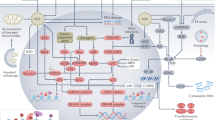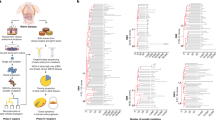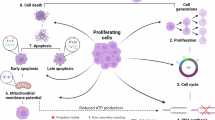Abstract
In mammals, the rate of somatic growth is rapid in early postnatal life but then slows with age, approaching zero as the animal approaches adult body size. To investigate the underlying changes in cell-cycle kinetics, [methyl-3H]thymidine and 5′-bromo-2′deoxyuridine were used to double-label proliferating cells in 1-, 2-, and 3-wk-old mice for four weeks. Proliferation of renal tubular epithelial cells and hepatocytes decreased with age. The average cell-cycle time did not increase in liver and increased only 1.7 fold in kidney. The fraction of cells in S-phase that will divide again declined approximately 10 fold with age. Concurrently, average cell area increased approximately 2 fold. The findings suggest that somatic growth deceleration primarily results not from an increase in cell-cycle time but from a decrease in growth fraction (fraction of cells that continue to proliferate). During the deceleration phase, cells appear to reach a proliferative limit and undergo their final cell divisions, staggered over time. Concomitantly, cells enlarge to a greater volume, perhaps because they are relieved of the size constraint imposed by cell division. In conclusion, a decline in growth fraction with age causes somatic growth deceleration and thus sets a fundamental limit on adult body size.
Similar content being viewed by others
Log in or create a free account to read this content
Gain free access to this article, as well as selected content from this journal and more on nature.com
or
Abbreviations
- BLI:
-
Brdu labeling index
- BrdU:
-
5′-bromo-2′deoxyuridine
- DLI:
-
double-labeling index
- 3H-thymidine:
-
[methyl-3H]thymidine
- HLI:
-
3H-thymidine labeling index
References
Goedbloed JF 1972 The embryonic and postnatal growth of rat and mouse. I. The embryonic and early postnatal growth of the whole embryo. A model with exponential growth and sudden changes in growth rate. Acta Anat (Basel) 82: 305–306
Hughes PC, Tanner JM 1970 A longitudinal study of the growth of the black-hooded rat: methods of measurement and rates of growth for skull, limbs, pelvis, nose-rump and tail lengths. J Anat 106: 349–370
Tanner JM, Davies PS 1985 Clinical longitudinal standards for height and height velocity for North American children. J Pediatr 107: 317–329
Rose SR, Municchi G, Barnes KM, Kamp GA, Uriarte MM, Ross JL, Cassorla F, Cutler GB Jr 1991 Spontaneous growth hormone secretion increases during puberty in normal girls and boys. J Clin Endocrinol Metab 73: 428–435
Juul A, Holm K, Kastrup KW, Pedersen SA, Michaelsen KF, Scheike T, Rasmussen S, Muller J, Skakkebaek NE 1997 Free insulin-like growth factor I serum levels in 1430 healthy children and adults, and its diagnostic value in patients suspected of growth hormone deficiency. J Clin Endocrinol Metab 82: 2497–2502
Nilsson O, Baron J 2004 Fundamental limits on longitudinal bone growth: growth plate senescence and epiphyseal fusion. Trends Endocrinol Metab 15: 370–374
Hume WJ 1989 DNA-synthesizing cells in oral epithelium have a range of cell cycle durations: evidence from double-labelling studies using tritiated thymidine and bromodeoxyuridine. Cell Tissue Kinet 22: 377–382
National Research Council 2003 Guide for the Care and Use of Laboratory Animals. National Academy Press, Washington, DC
Chwalinski S, Potten CS, Evans G 1988 Double labelling with bromodeoxyuridine and [3H]-thymidine of proliferative cells in small intestinal epithelium in steady state and after irradiation. Cell Tissue Kinet 21: 317–329
Hayes NL, Nowakowski RS 2002 Dynamics of cell proliferation in the adult dentate gyrus of two inbred strains of mice. Brain Res Dev Brain Res 134: 77–85
Nowakowski RS, Lewin SB, Miller MW 1989 Bromodeoxyuridine immunohistochemical determination of the lengths of the cell cycle and the DNA-synthetic phase for an anatomically defined population. J Neurocytol 18: 311–318
Painter RB, Drew RM, Hughes WL 1958 Inhibition of HeLa growth by intranuclear tritium. Science 127: 1244–1245
Post J, Hoffman J 1964 Changes in the replication times and patterns of the liver cell during the life of the rat. Exp Cell Res 36: 111–123
Schultze B, Kellerer AM, Grossmann C, Maurer W 1978 Growth fraction and cycle duration of hepatocytes in the three-week-old rat. Cell Tissue Kinet 11: 241–249
Ross DW 1976 Cell volume growth after cell cycle block with chemotherapeutic agents. Cell Tissue Kinet 9: 379–387
Enesco M, Leblond CP 1962 Increase in Cell Number As A Factor in Growth of Organs and Tissues of Young Male Rat. J Embryol Exp Morphol 10: 530–563
Winick M, Noble A 1965 Quantitative changes in DNA, RNA, and protein during prenatal and postnatal growth in the rat. Dev Biol 12: 451–466
Sands J, Dobbing J, Gratrix CA 1979 Cell number and cell size: organ growth and development and the control of catch-up growth in rats. Lancet 2: 503–505
Coles HS, Burne JF, Raff MC 1993 Large-scale normal cell death in the developing rat kidney and its reduction by epidermal growth factor. Development 118: 777–784
Author information
Authors and Affiliations
Corresponding author
Additional information
Financial Support: This research was supported by the Intramural Research Program of the National Institute of Child Health and Human Development, NIH.
Rights and permissions
About this article
Cite this article
Chang, M., Parker, E., Muller, T. et al. Changes in Cell-Cycle Kinetics Responsible for Limiting Somatic Growth in Mice. Pediatr Res 64, 240–245 (2008). https://doi.org/10.1203/PDR.0b013e318180e47a
Received:
Accepted:
Issue date:
DOI: https://doi.org/10.1203/PDR.0b013e318180e47a
This article is cited by
-
The bigger the better: determining nephron size in kidney
Pediatric Nephrology (2014)
-
A set of imprinted genes required for normal body growth also promotes growth of rhabdomyosarcoma cells
Pediatric Research (2012)
-
Early-occurring proliferation defects in peripheral tissues of the Ts65Dn mouse model of Down syndrome are associated with patched1 over expression
Laboratory Investigation (2012)



